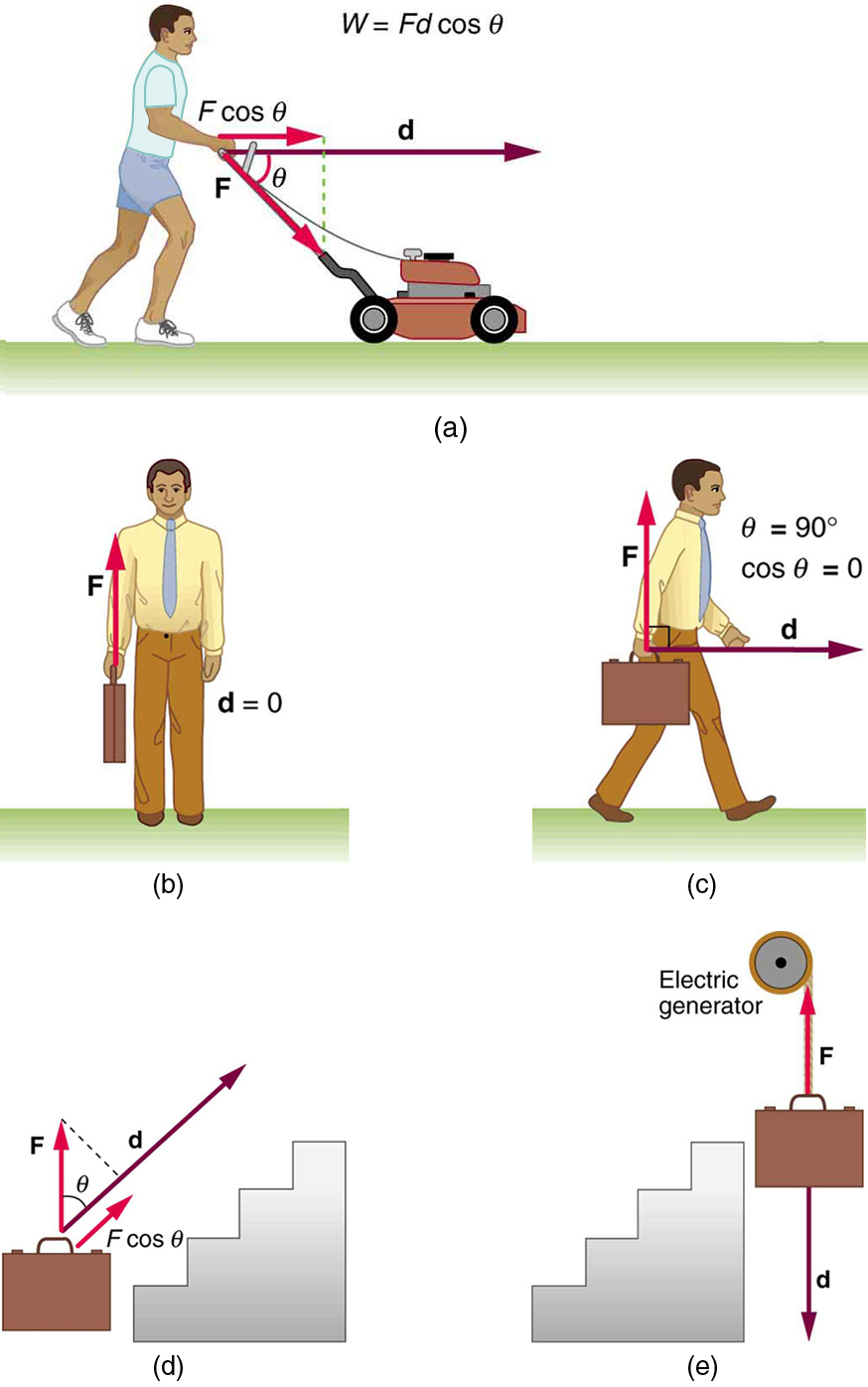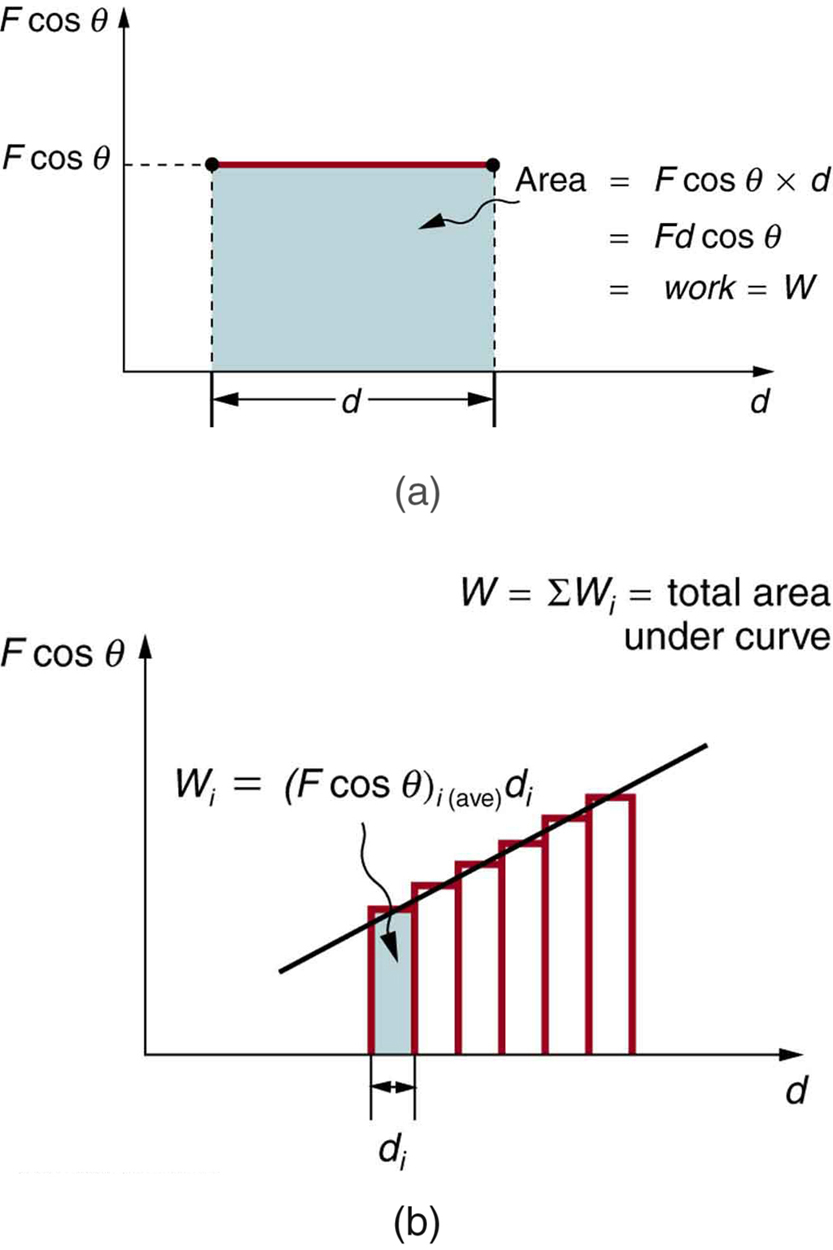Chapter 5: Work, Power, and Energy
5.2 Kinetic Energy and the Work-Energy Theorem
Authors: Paul Peter Urone, Roger Hinrichs
Adapted by: Rob Pryce, Alix Blacklin
Learning Objectives
By the end of this section, you will be able to:
- Explain work as a transfer of energy and net work as the work done by the net force.
- Explain and apply the work-energy theorem.
Work Transfers Energy

What happens to the work done on a system? Energy is transferred into the system, but in what form? Does it remain in the system or move on? The answers depend on the situation. For example, if the lawn mower in figure (a) above is pushed just hard enough to keep it going at a constant speed, then energy put into the mower by the person is removed continuously by friction, and eventually leaves the system in the form of heat transfer. In contrast, work done on the briefcase by the person carrying it up stairs in figure (d) above is stored in the briefcase-Earth system and can be recovered at any time, as shown in figure (e) above. In fact, the building of the pyramids in ancient Egypt is an example of storing energy in a system by doing work on the system. Some of the energy imparted to the stone blocks in lifting them during construction of the pyramids remains in the stone-Earth system and has the potential to do work.
In this section we begin the study of various types of work and forms of energy. We will find that some types of work leave the energy of a system constant, for example, whereas others change the system in some way, such as making it move. We will also develop definitions of important forms of energy, such as the energy of motion.
Net Work and the Work-Energy Theorem
We know from Newton's Second Law that net force causes acceleration. We will see in this section that work done by the net force gives a system energy of motion, and in the process we will also find an expression for the energy of motion.
Let us start by considering the total, or net, work done on a system. Net work is defined to be the sum of work done by all external forces—that is, net work is the work done by the net external force [latex]{\mathbf{F}}_{\text{net}}[/latex]. In equation form, this is [latex]{W}_{\text{net}}={F}_{\text{net}}d\phantom{\rule{0.25em}{0ex}}\text{cos}\phantom{\rule{0.25em}{0ex}}\theta[/latex] where [latex]\theta[/latex] is the angle between the force vector and the displacement vector.
Figure (a) below shows a graph of force versus displacement for the component of the force in the direction of the displacement—that is, an [latex]F\phantom{\rule{0.25em}{0ex}}\text{cos}\phantom{\rule{0.25em}{0ex}}\theta[/latex] vs. [latex]d[/latex] graph. In this case, [latex]F\phantom{\rule{0.25em}{0ex}}\text{cos}\phantom{\rule{0.25em}{0ex}}\theta[/latex] is constant. You can see that the area under the graph is [latex]Fd\phantom{\rule{0.25em}{0ex}}\text{cos}\phantom{\rule{0.25em}{0ex}}\theta[/latex], or the work done. Figure (b) below shows a more general process where the force varies. The area under the curve is divided into strips, each having an average force [latex]\left(\text{F}\text{cos}\theta\right)_{i\left(\text{ave}\right)}[/latex]. The work done is [latex]\left(\text{F}\text{cos}\theta\right)_{i\left(\text{ave}\right)}{d}_{i}[/latex] for each strip, and the total work done is the sum of the [latex]{W}_{i}[/latex]. Thus the total work done is the total area under the curve, a useful property to which we shall refer later.

Net work will be simpler to examine if we consider a one-dimensional situation where a force is used to accelerate an object in a direction parallel to its initial velocity. Such a situation occurs for the package on the roller belt conveyor system shown in Figure 7.5.

The force of gravity and the normal force acting on the package are perpendicular to the displacement and do no work. Moreover, they are also equal in magnitude and opposite in direction so they cancel in calculating the net force. The net force arises solely from the horizontal applied force [latex]{\mathbf{F}}_{\text{app}}[/latex] and the horizontal friction force [latex]\mathbf{f}[/latex]. Thus, as expected, the net force is parallel to the displacement, so that [latex]\theta =0º[/latex] and [latex]\phantom{\rule{0.25em}{0ex}}\text{cos}\phantom{\rule{0.25em}{0ex}}\theta =1[/latex], and the net work is given by
The effect of the net force [latex]{\mathbf{F}}_{\text{net}}[/latex] is to accelerate the package from [latex]{v}_{0}[/latex] to [latex]v[/latex]. This causes the kinetic energy of the package to increase, because the net work done on the system was positive. By using Newton’s second law, and doing some algebra, we can reach an interesting conclusion. Substituting [latex]{F}_{\text{net}}=\text{ma}[/latex] from Newton’s second law into our work equation gives:
To get a relationship between net work and the speed given to a system by the net force acting on it, we take [latex]d=x-{x}_{0}[/latex] (i.e. a displacement) and then can use the equations for motion under constant acceleration. The change in speed of an object over a displacement d can be determined by [latex]{v}^{2}={{v}_{0}}^{2}+2\text{ad}[/latex]. If we solve that equation for acceleration, we get [latex]a=\frac{{v}^{2}-{{v}_{0}}^{2}}{2d}[/latex]. Lastly, we can substitute this acceleration [latex]a[/latex] into our work equation from above, we obtain:
The [latex]d[/latex] cancels, and we simplify this to obtain:
This expression is called the work-energy theorem, and it actually applies in general (even for forces that vary in direction and magnitude), although we have derived it for the special case of a constant force parallel to the displacement. The theorem implies that the net work on a system equals the change in the quantity [latex]\frac{1}{2}{\text{mv}}^{2}[/latex]. This quantity is our first example of a form of energy.
The Work-Energy Theorem
The net work on a system equals the change in the quantity [latex]\frac{1}{2}{\text{mv}}^{2}[/latex].
is the energy associated with linear motion. Kinetic energy is a form of energy associated with the motion of a particle, single body, or system of objects moving together.
We are aware that it takes energy to get an object, like a car or the package in Figure 7.5, up to speed, but it may be a bit surprising that kinetic energy is proportional to speed squared. This proportionality means, for example, that a car traveling at 100 km/h has four times the kinetic energy it has at 50 km/h, helping to explain why high-speed collisions are so devastating. We will now consider a series of examples to illustrate various aspects of work and energy.
Calculating the Kinetic Energy of a Package
Suppose a 30.0-kg package on the roller belt conveyor system in Figure 7.4 is moving at 0.500 m/s. What is its kinetic energy?
Strategy
Because the mass [latex]m[/latex] and speed [latex]v[/latex] are given, the kinetic energy can be calculated from its definition as given in the equation [latex]\text{KE}=\frac{1}{2}{\text{mv}}^{2}[/latex].
Solution
The kinetic energy is given by
Entering known values gives
which yields
Discussion
Note that the unit of kinetic energy is the joule, the same as the unit of work, as mentioned when work was first defined. It is also interesting that, although this is a fairly massive package, its kinetic energy is not large at this relatively low speed. This fact is consistent with the observation that people can move packages like this without exhausting themselves.
Determining the Work to Accelerate a Package
Suppose that you push on the 30.0-kg package in Figure 7.4 with a constant force of 120 N through a distance of 0.800 m, and that the opposing friction force averages 5.00 N.
(a) Calculate the net work done on the package.
(b) Solve the same problem as in part (a), this time by finding the work done by each force that contributes to the net force.
Strategy and Concept for (a)
This is a motion in one dimension problem, because the downward force (from the weight of the package) and the normal force have equal magnitude and opposite direction, so that they cancel in calculating the net force, while the applied force, friction, and the displacement are all horizontal. As expected, the net work is the net force times distance.
Solution for (a)
The net force is the push force minus friction, or [latex]{F}_{\text{net}}\text{= 120 N – 5}\text{.}\text{00 N = 115 N}[/latex]. Thus the net work is
Discussion for (a)
This value is the net work done on the package. The person actually does more work than this, because friction opposes the motion. Friction does negative work and removes some of the energy the person expends and converts it to thermal energy. The net work equals the sum of the work done by each individual force.
Strategy and Concept for (b)
The forces acting on the package are gravity, the normal force, the force of friction, and the applied force. The normal force and force of gravity are each perpendicular to the displacement, and therefore do no work.
Solution for (b)
The applied force does work.
The friction force and displacement are in opposite directions, so that [latex]\theta =\text{180º}[/latex], and the work done by friction is
So the amounts of work done by gravity, by the normal force, by the applied force, and by friction are, respectively,
The total work done as the sum of the work done by each force is then seen to be
Discussion for (b)
The calculated total work [latex]{W}_{\text{total}}[/latex] as the sum of the work by each force agrees, as expected, with the work [latex]{W}_{\text{net}}[/latex] done by the net force. The work done by a collection of forces acting on an object can be calculated by either approach.
Determining Speed from Work and Energy
Find the speed of the package in Figure 7.4 at the end of the push, using work and energy concepts.
Strategy
Here the work-energy theorem can be used, because we have just calculated the net work, [latex]{W}_{\text{net}}[/latex], and the initial kinetic energy, [latex]\frac{1}{2}{m{v}_{0}}^{2}[/latex]. These calculations allow us to find the final kinetic energy, [latex]\frac{1}{2}{\text{mv}}^{2}[/latex], and thus the final speed [latex]v[/latex].
Solution
The work-energy theorem in equation form is
Solving for [latex]\frac{1}{2}{\text{mv}}^{2}[/latex] gives
Thus,
Solving for the final speed as requested and entering known values gives
Discussion
Using work and energy, we not only arrive at an answer, we see that the final kinetic energy is the sum of the initial kinetic energy and the net work done on the package. This means that the work indeed adds to the energy of the package.
Work and Energy Can Reveal Distance, Too
How far does the package in Figure 7.4 coast after the push, assuming friction remains constant? Use work and energy considerations.
Strategy
We know that once the person stops pushing, friction will bring the package to rest. In terms of energy, friction does negative work until it has removed all of the package’s kinetic energy. The work done by friction is the force of friction times the distance traveled times the cosine of the angle between the friction force and displacement; hence, this gives us a way of finding the distance traveled after the person stops pushing.
Solution
The normal force and force of gravity cancel in calculating the net force. The horizontal friction force is then the net force, and it acts opposite to the displacement, so [latex]\theta =\text{180º}[/latex]. To reduce the kinetic energy of the package to zero, the work [latex]{W}_{\text{fr}}[/latex] by friction must be minus the kinetic energy that the package started with plus what the package accumulated due to the pushing. Thus [latex]{W}_{\text{fr}}=-\text{95}\text{.}\text{75 J}[/latex]. Furthermore, [latex]{W}_{\text{fr}}=fd \phantom{\rule{0.25em}{0ex}}\text{cos}\phantom{\rule{0.25em}{0ex}}\theta \phantom{\rule{0.25em}{0ex}}\text{= –}fd[/latex], where [latex]d\prime[/latex] is the distance it takes to stop. Thus,
and so
Discussion
This is a reasonable distance for a package to coast on a relatively friction-free conveyor system. Note that the work done by friction is negative (the force is in the opposite direction of motion), so it removes the kinetic energy.
Some of the examples in this section can be solved without considering energy, but at the expense of missing out on gaining insights about what work and energy are doing in this situation. On the whole, solutions involving energy are generally shorter and easier than those using kinematics and dynamics alone.

